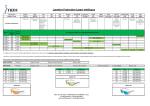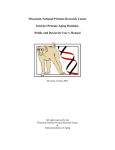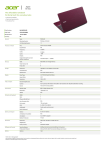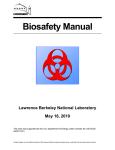Download Laser Reference Guide
Transcript
Laser Reference Guides Cradle to Grave Ken Barat CLSO LSO Workshop 2012 What is this? Taking a cradle to grave approach the laser safety program at LBNL has developed three laser user guides. A laser lab design guide A laser user reference guide A laser disposal guide The presentation will review the rationale and substance of each guide as well as the value it gives to the laser user and laser safety program. As well as how to obtain free copies, FREE, FREE, FREE, FREE The problem Skill of the Craft is an assumption that has lead to many an accident We face a similar problem with laser users in the research setting, in particular when Graduate and Post Doc students make up much of the work force “They can handle it” All to often senior researchers and safety staff, in particular Laser Safety Officers relay on knowledge we perceive our user population has Experience has shown that this population is not always as knowledgeable or lab smart as one might think The Solution The laser safety program at Lawrence Berkeley National Laboratory (LBNL) has developed and made available to our users three laser guides These guides present a “Cradle to Grave” knowledge booster or crutch to our users Lab Design Guide Laser Reference Guide (user guide) Laser Disposal Guide Riddle of the Sphinx In Greek mythology, the Sphinx sat outside of Thebes and asked this riddle of all who passed by. If the traveler failed to solve the riddle, then the Sphinx killed him/her. And if the traveler answered the riddle correctly, then the Sphinx would destroy herself. The riddle: What goes on four legs in the morning, on two legs at noon, and on three legs in the evening? Oedipus solved the riddle, and the Sphinx destroyed herself. Answer is a Man, Who crawls on all fours as a baby Walks on two legs as an adult Walks with a cane in old age. AM or Cradle Laser Lab Design Guide Information on setting up a laser lab I Find a disconnect between researchers and project managers Researchers do not know building codes Project managers do not know or appreciate laser operational needs This lack of appreciation or understanding has been the cause of many laser & safety related problems as well as wasted funds Table of Contents Section 1 Exterior Design Access Control/Controlled Entry: Door Interlock System Electronic Lock Posting Door Notes Illuminated Warning Sign Sign Conditions Eyewear Storage Storage Considerations Windows Window Options Door Postings Emergency Crash Off Switch Section 2 Interior Layout Optical Table Before the Tables Arrive The Optical Table is in Place Which Way are the Beams Pointing? Enclosures/Barriers Perimeter Guard Complete Table Barriers Local Blocks- Beam Blocks Beam Path Management Shelves Over Tables Work Station Rack Unit Curtain Area Section 3A Environmental Factors: Utilities Temperature Control Chillers Ventilation Vacuum Pumps Lighting Fire Suppression Emergency Exit Electrical Power Eyewash/Shower station Gas Shut Off Section 3B InteriorInstitutional Items: Space Around Electrical Panel Seismic Bracing Flooring Storage (Chemicals, Flammable Liquids, Gases) Storage Space for Supplies Chemical storage Gas Storage Flammable Liquid Storage Biological Storage Radioactive Waste Cryogen Use Superconducting Magnet 4…..Human Factors: Walkway Spacing Reach Issues Workstation Locations Storage Space Wall units Instrument Location Section 5, Abbreviated Checklist. Points to items to be considered Appendix A: Laboratory Lessons Look & Learn Blocking air currents & particulates Shelving too low for equipment Poor layout Cover over crash button Cover stops button from working Power supply blocks sink, poor layout planning Not most stable platform for a pump Can you find the shelf on wall? Better can you reach the shelf? What ever is in it will stay forever Table too close to panel Cable tray too low Sign too high Cable management, guess…Poor Great lab designed device for connecting beam tubes, shutters if tube falls out or not in place Homemade at LBNL E-Stop unreachable Clearance at panel Simple & inexpensive solution to reduce head injuries Padding around shelf, good idea & inexpensive Other examples, I am sure there are some in your own labs Afternoon- Lab Life Laser Reference Guide Purpose to be a resource for laser user on real laser and optic usage As well as safety hints Sections could serve as On the Job Training resource Chapters The guide is 100 pages with stand alone sections Topics and examples covered are many here is a sampling: On the job training General Consideration for being in a laser lab Laser Safety Tools Wavelength Specific Information and Best Practices Precautions: Optics on Your Table Know your optics Fiber optics Appendixes Appendix A: Alignment Guidelines Getting ready Recommended Alignment Methods Appendix B: Eyewear Selection Comfort and fit Optical Density (OD) Appendix C: Accidents Appendix D: Nature of Light Appendix E: How to Select Optical Mounts Gimbal Mounts Choosing optics Appendix F: Laser Bio-effects Exposure Type The Eye Damage Mechanisms Laser Radiation Effects on Skin Appendix G: Bibliographic References PM end of life cycle Laser Disposal Guide What to do with old lasers? How should salvage handle them? What is your liability? The guide starts with a set of questions to three different groups: User Hazardous Waste Generator Assistant Surplus receiver User Have you contacted Property Management to ask which forms need to be filled out? If you are disposing of a Dye or Excimer laser, have you flushed out the chemicals in the pump containers, tubing and inner cavity? For instructions, please see the Dye Laser or Excimer Laser sections. Do you have the user manual for the laser? If so, send it for disposal with the laser. Did you contact the LSO to see if he can find a new home for your laser? Remember to remove the laser from your AHD inventory Hazardous Waste Generator Assistant If it is a Dye or Excimer laser, ensure the user has flushed out the chemicals in the pump containers, tubing and inner cavity. Ensure all collected chemicals are packaged, labeled and stored correctly for waste disposal. See the Dye Laser section for list of common laser dyes and solvents Majority of power supplies built prior to 2000 with capacitors will contain capacitor oil. Ensure such oils are collected, labeled and stored correctly for waste disposal. Any other type of laser has no special precautions required for transportation Surplus receiver Have you received the proper paperwork? Is the laser type identified, so the proper disposal steps can be taken? Disposal steps are outlined in this guide per laser type. Table of Contents Action Points/Questions to Ask Yourself User Responsibilities Government Regulations on Export Controls Transportation Concerns General Approaches to Disposal of Laser Actions to follow if LBNL is Disposing of the Laser Power Supplies Type of Lasers – Lasing Medium Dye Lasers Excimer Lasers Gas Lasers Solid State and Rod Lasers Diode and Semiconductor Lasers Diode/Telecommunications Laser Systems Optical Parametric Oscillators and Amplifiers (OPO/OPA) APPENDIX A: Vendors Specializing in Selling Used Laser Equipment APPENDIX B: Electronics Recyclers APPENDIX C: Overview on Lasers What is a Laser? How Lasers Work APPENDIX D: MSDS Health Hazards for Common Chemicals Found in Lasers What is the MSDS? Where to Find the MSDS? APPENDIX E: Export Control Websites Solid State Laser ACTIVE CONCERN Some of these are on export control list. Circuit boards may contain lead. COMMON SOLID STATE LASERS •Alexandrite Laser •Erbium: Glass •Ho: YAG •Nd: YAG Laser •Nd: YLF •Nd: YVO4 •Ruby Laser •Ti: Sapphire •Yb: YAG •Ruby DISPOSAL Remove power cord, remove circuit boards (e-waste), and remove any obvious optics or crystal rods. Place the optics in a ziplock bag, label the bag and send it to the LSO. Wear protective eyewear and safety gloves. Small quantity of Gallium Arsenide can be found in diodes. Of the laser systems noted above, most contain Rod lasers modules that generally contain Xenon or Krypton Arc “Flash Lamps” that serve as the excitation mechanism for the laser medium. By the nature of these components, extreme care needs to be taken when handling the flash lamps as they can potentially explode and/or break upon removal. Treat like glass bulb waste . Next slide Hazardous Materials to Consider •Alexandrite •YAG •Gallium Arsenide •Images of laser & list of common manufacturers follow Almost at the end These guides were developed to fill a gap that the Laser Safety Program at LBNL felt needed to be filled They do not replace many existing resources, but attempts to increase user awareness in a format they might use How well they accomplish this varies with and how people use them Disposal guide requires the time to apply its recommendations, which salvage may not have or the room to let things sit while waiting on answers Layout guide maybe rejected by institutional facilities organizations, seen as stepping on their tuff Reference Guide, could be seen as a OJT guide Summary The goal of the guides is to answer questions and fill in knowledge gaps If you have questions or suggestions please contact me After 9/28 at the email below [email protected] Thank you and any questions now?








































